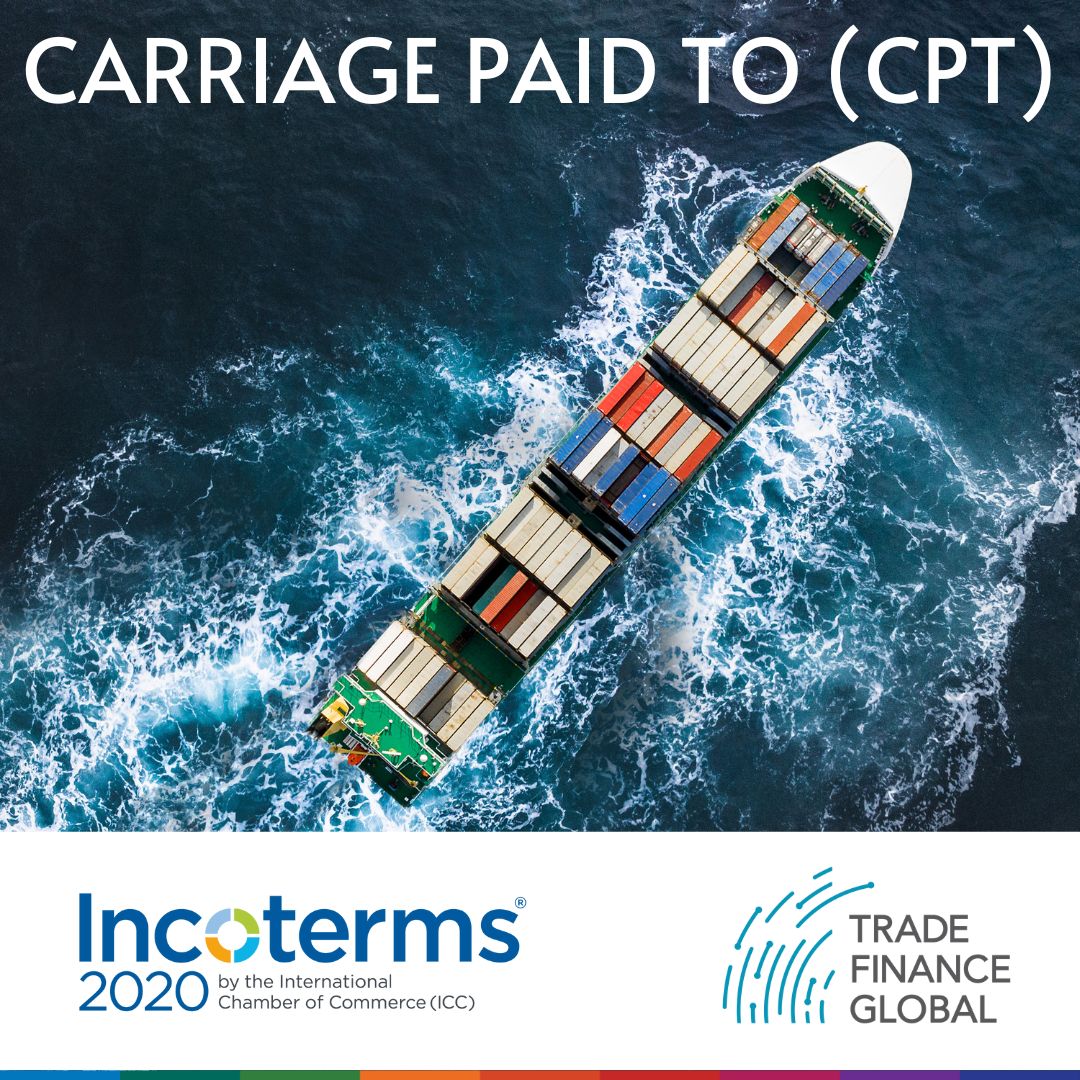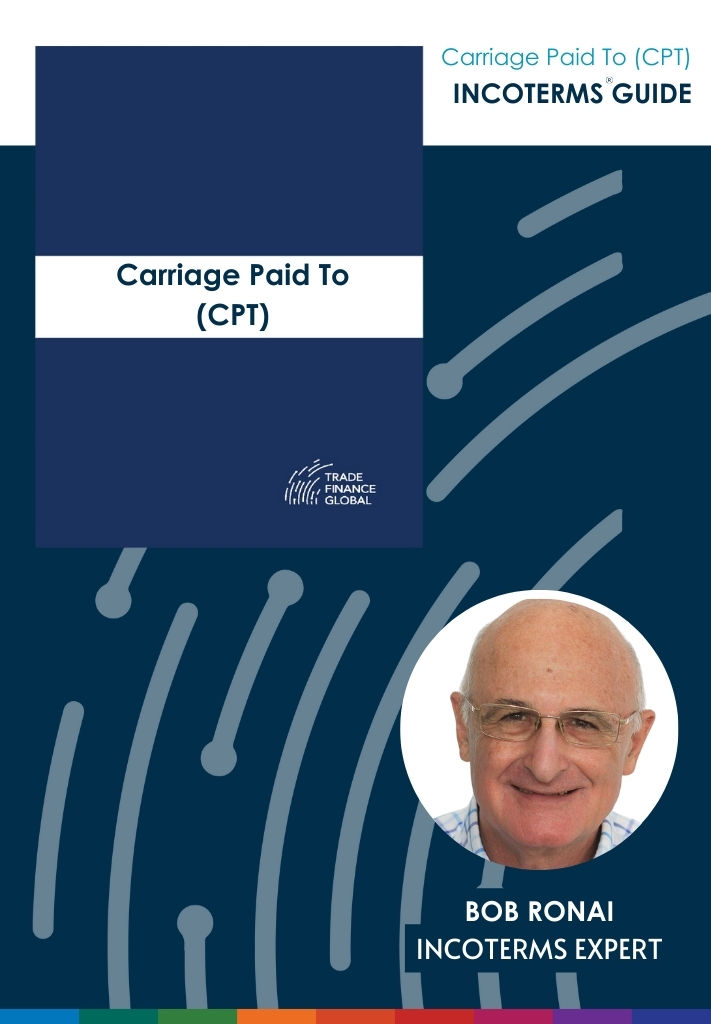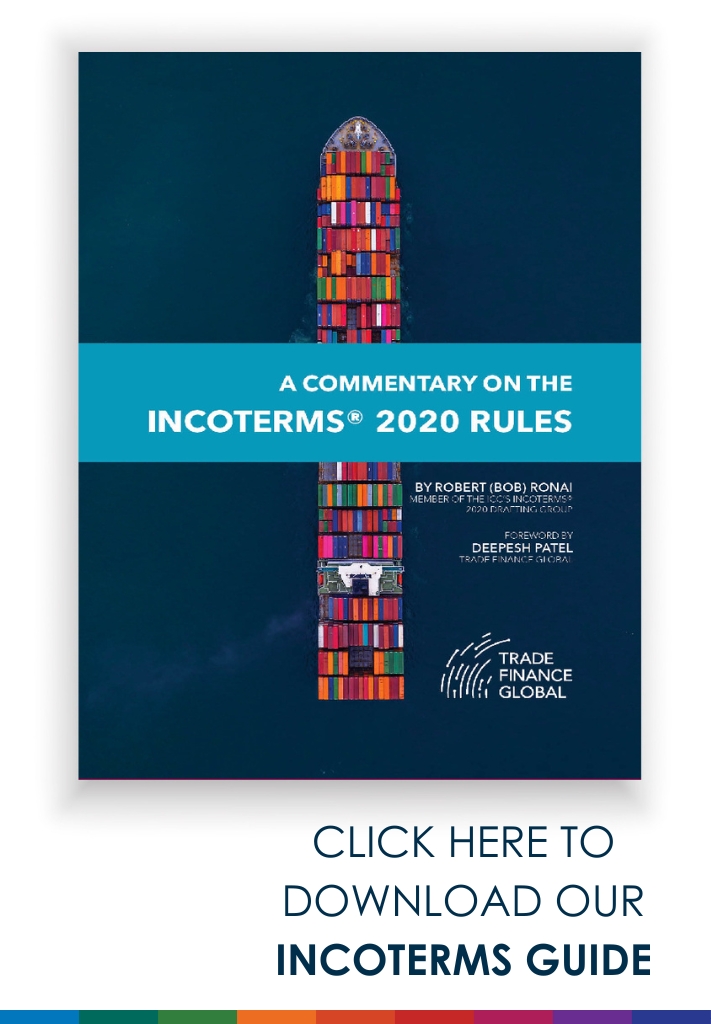“Carriage Paid To”, or CPT, is an Incoterms rule that can be used for any transport mode.
It goes into more detail than FCA, specifying that the seller bears the costs for transporting the goods to the Buyer’s nominated place and that the risk transfers from the seller to the buyer once the carrier takes charge of the goods at the nominated destination.
Contents
Introduction to the Carriage Paid To Incoterms rule
Carriage Paid To Incoterms 2020 rule – key changes and updates
Carriage Paid To podcast
Carriage Paid To buyer and seller obligations – rule by rule
Carriage Paid To – advantages and disadvantages
Carriage Paid To – diagram
Using CPT with a letter of credit
Carriage Paid To – video
Next Incoterms Rules – Carriage and Insurance Paid To
Carriage Paid To (CPT) Incoterms 2020 Rules Guide

A short 16-page guide on the Carriage Paid To (CPT) Incoterms® 2020 Rule, to be used in conjunction with The International Chamber of Commerce’s (ICC) new book, INCOTERMS® 2020.
This short guide provides an article by article commentary on the Carriage Paid To Incoterms® Rule.
Introduction to Carriage Paid To (CPT)
The Carriage Paid To (CPT) rule states that the seller must deliver the goods to its carrier, but it doesn’t specify whether this delivery happens at the seller’s premises with the goods loaded onto the collecting vehicle or at another location without unloading from the seller’s vehicle.
The seller is responsible for handling all export procedures, while the buyer manages import formalities.
Under CPT, the seller must also arrange and pay for the transportation, a cost typically reflected in the sale price, and, similar to the Free Carrier (FCA) Incoterm, the risk shifts to the buyer as soon as the goods are delivered.
This rule is particularly effective for land transportation within the European and Central Asian region, where it is common for the same truck that picks up the goods to deliver them directly to their final destination.
Carriage Paid To (CPT) diagram 2024

Diagram: CPT – The seller bears the costs for transporting the goods to the nominated place. The risk transfers from the seller to the buyer as soon as the goods reach the nominated destination and the carrier takes charge. Source: ICC
Carriage Paid To Incoterms 2020 rule – key changes and updates
The CPT rule under Incoterms 2020 has two important places, the place of delivery in the seller’s country and the destination to where the seller contracts the carriage.
It is vital not to confuse the two.
Despite being recommended in place of the CFR Incoterm for cross-ocean container shipments, in practice, CPT is largely unworkable for them.
This is because, in cross-ocean container shipments, most buyers do not want to bear the risk of loss or damage until the goods have actually been exported, nor do they want to deal with any problems that might occur while the goods are still in the exporting country.
Until the goods reach the border, the buyer will be unaware of when or where delivery has occurred and who will be carrying it, as it will be the seller’s carrier.
The seller has no obligation to put the goods on board a ship by a given date, but as it is using its own contracted carrier, it should be easily able to obtain an onboard bill of lading.

Difference between CPT and CIP
Carriage Paid To (CPT) and Carriage Insurance Paid To (CIP) may be similar Incoterms rules, but they have one key difference: insurance.
Under CPT, the seller is responsible for:
- export packing,
- loading charges,
- delivery to port/place,
- export duties and taxes,
- origin terminal charges,
- loading on carriage,
- carriage charges, and
- destination terminal charges.
and the buyer is responsible for:
- Delivery to destination and
- import duties and taxes.
Responsibility for insurance is not explicitly delineated in CPT.
CIP follows this same structure, except that it adds insurance to the seller’s list of responsibilities. CIP is one of only two Incoterms rules explicitly laying out the responsibility for insurance (the other being Cost, Insurance, and Freight (CIF)).
Carriage Paid To (CPT) Podcast
Carriage Paid To seller and buyer obligations – rule by rule
A1 (General Obligations)
In each of the eleven rules, the seller must provide the goods and their commercial invoice as required by the contract of sale and any other evidence of conformity, such as an analysis certificate that might be relevant and specified in the contract.
Each of the rules also provides that any document can be in paper or electronic form as agreed in the contract, or if the contract makes no mention of this, then the rules default to what is customary.
The rules do not explicitly define what “electronic form” is. This ambiguity means that it can be anything from a .pdf file to a blockchain record or another format yet to be developed.
B1 (General obligations)
In each of the rules, the buyer must pay the price for the goods as stated in the contract of sale.
The rules do not refer to when the payment is to be made (e.g., before shipment, immediately after shipment, thirty days after shipment, etc.) or how it is to be paid (e.g., prepayment, against an email of copy documents, on presentation of documents to a bank under a letter of credit, etc.).
These matters should be specified in the contract.
A2 (Delivery)
Under CPT, the seller “delivers” the goods by handing them over to its contracted carrier on the agreed date or within the agreed period (not when the goods reach the final destination).
There has in the past been some confusion because Incoterms® 2000 referred to “the first carrier” if there were subsequent carriers.
In practice, there may well be several carriers contracted in turn by the seller’s contracted carrier, such as the truck collecting the goods and taking them to the airport terminal, the cargo handler contracted by the airline to move the goods to the aircraft and load them onto it, the airline itself, and the repeat of these at the other end. But the only carrier of concern is the carrier contracted to move the goods from the point of delivery to the destination.
Most importantly, delivery occurs when the seller passes the goods to their carrier to transport them, not when the goods reach the destination.
B2 (Delivery)
The buyer must take delivery when they have been handed to the seller’s carrier and physically receive the goods at the named place, or point within that place, of destination.
A3 (Transfer of risk)
In all the rules, the seller bears all risks of loss or damage to the goods until they have been “delivered” in accordance with A2 described above.
The exception is loss or damage in circumstances described in B3 below, which varies depending on the buyer’s role in B2.
B3 (Transfer of risk)
The buyer bears all risks of loss or damage to the goods once the seller has “delivered” them as described in A2.
If the contract requires the buyer to inform the seller of the time for dispatching the goods or the point of receiving the goods within the destination place, and the buyer fails to do so, then the buyer bears the risk of loss or damage to the goods from the agreed date or the end of the agreed period.
For example, if the buyer does not inform the seller where they are to send the goods, how can the seller dispatch them?
If the seller has clearly identified the goods, then the risk transfers to the buyer either on the agreed date or at the end of the agreed period.
A4 (Carriage)
Under CPT, the seller must contract for the carriage of the goods or procure such a contract if this is one leg of a “string” sale.
The contract must be from the place of delivery and maybe an agreed point within that place. It must be made on “usual terms” and for the “usual route in a customary manner of the type used by the carriage of the type of goods sold.” If the seller and buyer agree on specific matters regarding the contract of carriage, that is well and good, but if they don’t, then the seller must arrange it in the usual manner for those goods.
As the seller has to arrange the carriage it needs to know from the buyer if there is a specific point in the place of destination to which the goods must be transported.
For example, if the destination is shown as simply “New Delhi, India”, where in that large metropolis is the seller’s carrier to leave the goods?
It could be that it is to be the buyer’s premises, or a particular location, say in a green-fields building site, or the carrier’s premises, or the airport, or the container yard… the exact point should be agreed upon. If it is not, then it is the seller’s choice to select the point that best suits its purpose, which will usually be the cheapest option, such as a cargo terminal.
If the delivery at the destination is to occur after the buyer completes any necessary import formalities, then the cost of storage due to delays in those formalities being completed is for the buyer, always assuming the seller has provided the buyer with necessary documents in time.
The seller must comply with any transport-related security requirements for the whole of the transport to the destination.
B4 (Carriage)
The buyer has no obligation to the seller to arrange a contract of carriage.
A5 (Insurance)
Since the seller does not have the risk beyond the moment of “delivery” under CPT, it has no obligation to the buyer to arrange a contract of insurance.
However, if the buyer requests information from the seller that they need to arrange its insurance, the seller must provide it, albeit at the buyer’s risk and cost. If there is any information the buyer requests that the seller does not already know, the seller can, and probably would, choose to assist.
Nevertheless (and the Incoterms® 2020 rules do not cover this), a wise seller would investigate taking out marine insurance on a contingency basis. If the goods are lost or damaged in transit, causing the buyer to refuse to pay for them, the seller will want to have a fallback of being able to claim on its own marine insurance.
B5 (Insurance)
Despite having the risk of loss or damage to the goods from the delivery point, the buyer does not have an obligation to the seller to insure the goods.
Whether the buyer chooses to insure the goods or bear the risk themselves is entirely their choice.
A6 (Delivery / Transport document)
When using CPT, the seller must provide the buyer (at the seller’s cost) with the usual transport documents for the transport agreed under A4, if it is customary or the buyer requests it.
As CPT and CIP cover any mode of transport, the specific form of the transport documentation will depend on the specific mode (or modes) used.
If the modes include carriage by sea (such as in full container load (FCL) or less than container load (LCL) transactions) then the seller is usually responsible for obtaining a sea waybill or bill of lading.
If the latter is issued in a negotiable form and in several originals, then a full set of those originals must be presented to the buyer, sometimes through the seller’s bank to the buyer’s bank under a letter of credit.
If the mode includes the goods going by air then typically an air waybill will be issued and if requested the seller will be given one “original for shipper” but this is not a negotiable transport document.
Shipment by truck might involve the issue of a CMR in Europe (which stands for “Convention on the Contract for the International Carriage of Goods Wholly or Partly by Road“) or simply some form of consignment note or truck waybill. These, too, are not negotiable.
Shipment by rail similarly will usually be covered by some form of rail consignment note that is not negotiable.
The transport document must cover the movement of the contracted goods within the agreed period for shipment. If it is agreed, then this document must enable the buyer to claim the goods from the carrier at the named destination and, subsequently, enable the buyer to sell the goods in transit to a secondary buyer by transferring that document. This would usually be in the form of a negotiable bill of lading.
B6 (Delivery / Transport document)
The buyer must accept the transport document provided by the seller so long as it conforms with the contract.
A7 (Export / Import clearance)
CPT, like all the multimodal rules, is suitable for both domestic and international transactions.
Where applicable, the seller must (at its own risk and cost) carry out all export clearance formalities required by the country of export, such as licences or permits, security clearance for export, or pre-shipment inspection.
The seller has no obligation to arrange any transit or import clearances.
However, if the buyer requests it (at its own risk and cost), the seller must assist in obtaining any documents or information which relate to formalities required by the country of transit or import, such as permits or licences, security clearance, or pre-shipment inspection required by the authorities.
B7 (Export / Import clearance)
Where applicable, the buyer must assist the seller (at the seller’s request, risk, and cost) in obtaining any documents or information needed for all export-related formalities required by the country of export.
Where applicable, the buyer must carry out and pay for all formalities required by any country of transit and the country of import.
These include:
- licences and permits required for transit,
- import licences and permits required for import,
- import clearance,
- security clearance for transit and import,
- pre-shipment inspection, and
- any other official authorisations and approvals.
Under CPT, these are the buyer’s responsibility because they occur after “delivery” by the seller.
At first glance it might seem strange that both seller and buyer have responsibility for pre-shipment inspections. To clarify, the seller is responsible if it is a requirement of the country of export, and the buyer is responsible if it is a requirement of the country of transit or import.
A8 (Checking / Packaging / Marking)
In all rules, the seller must pay the costs of any checking operations which are necessary for delivering the goods, such as checking quality, and measuring, packaging, weighing, or counting the goods.
The seller must also package the goods (at its own cost) unless it is usual for this particular good to be sold unpackaged, such as in the case of bulk goods.
The seller must also take into account the transport of the goods and package them appropriately unless the parties have agreed in their contract that the goods be packaged or marked in a specific manner.
B8 (Checking / Packaging / Marking)
In all rules there is no obligation from the buyer to the seller as regards packaging and marking. There can, in practice, however, be agreed exceptions, such as when the buyer provides the seller with labels, logos, or similar.
A9 (Allocation of costs)
The seller must pay all costs until the goods have been delivered under A2, except any costs the buyer must pay as stated in B9.
This means that under CPT, the seller must pay:
- any transport costs resulting from the contract of carriage, including costs of loading the goods and any transport-related security,
- the cost of providing the buyer with proof that the goods have been delivered,
- unloading costs at the agreed destination (if this is included in the contract of carriage, which it typically is for most shipments),
- any costs of transit included in the contract of carriage, and
- any costs, export duties and taxes, where applicable, related to export clearance.
Further, if the seller requests that the buyer provide any information or documents in relation to export clearance, then the seller must pay the buyer for these costs.
B9 (Allocation of costs)
Under CPT, the buyer must pay:
- unloading costs (unless they were paid by the seller under the contract of carriage),
- any costs of the country of transit (unless they have been paid by the seller under the contract of carriage),
- any duties, taxes, and other costs for import clearance, where applicable, and
- all costs relating to the goods from when they have been delivered (other than those that are payable by the seller).
Further, if the buyer requests the seller to assist in obtaining information or documents needed for the buyer to effect insurance and import formalities, then the buyer must reimburse the seller’s costs.
A10 (Notices)
The “C” Incoterms rules (i.e., CFR, CIF, CPT, CIP), as we have seen before, involve two distinct points:
- The seller must give the buyer notice that the goods have been “delivered” (per the conditions in A2).
- The seller must give the buyer any notice that the buyer will need to enable them to receive the goods.
The manner in which this will be done is usually detailed in the contract. It could be as simple as an email or might require copies of shipping documents being delivered.
B10 (Notices)
If the parties agree in the contract that the buyer is entitled to determine the time for the seller to deliver the goods, and possibly more importantly, the point within the named place of destination where it will receive the goods, the buyer must give the seller sufficient notice.
The contract will usually detail how much notice is to be given, and this might vary with the modes of transport.
Incoterms 2020 Rules PDF

A comprehensive 96 page guide on Incoterms® 2020, to be used in conjunction with The International Chamber of Commerce’s (ICC) new book, INCOTERMS® 2020.
Written by Bob Ronai CDCS, a member of the ICC’s Incoterms® 2020 Drafting Group, in partnership with Trade Finance Global (TFG). This 94 page guide provides an article by article commentary on Incoterms® 2020.
- Introduction and layout of the rules
- A1 / B1: GENERAL OBLIGATIONS
- A2 / B2: DELIVERY
- A3 / B3: TRANSFER OF RISK
- A4 / B4: CARRIAGE
- A5 / B5: INSURANCE
- A6 / B6: DELIVERY/TRANSPORT DOCUMENT
- A7 / B7: EXPORT/IMPORT CLEARANCE
- A8 / B8: CHECKING / PACKAGING / MARKING
- A9 / B9: ALLOCATION OF COSTS
- A10 / B10: NOTICES
- Advantages and Disadvantages of each rule and whether they work with LCs
- Rules for Any Mode or Modes of Transport
- Rules for Sea and Inland Waterway Transport
- Conclusions
Carriage Paid To (CPT): advantages and disadvantages
This rule was first published in Incoterms® 1980 as DCP (Freight Carriage Paid To). It was changed in Incoterms® 1990 to the current CPT.
CPT has a number of advantages for the seller.
Advantages
If the seller has large numbers of goods to despatch daily or on a regular basis, then using CPT allows it to use its own carrier, making it far easier to coordinate the loading of trucks at its despatch dock. Conversely, if the parties used FCA, where each buyer arranged its own carrier, it could be chaos at the loading dock.
Another advantage occurs when the seller has better buying power for freight than the buyer. In this case, the buyer would usually benefit from lower rates built into the price, and the seller would benefit from adding its own margin. Additionally, the buyer would not need to worry about logistics in the seller’s country, something that can be particularly challenging given the vast geographic and cultural distances that might be involved.
Despite the destination place following the three letters “CPT”, delivery occurs when the seller gives the goods to its carrier contracted to take them to that destination. It is at that delivery point in the seller’s country that the risk transfers from the seller to the buyer.
The rule gives no definition of where a “place” might be, it will depend entirely on what the seller and buyer have agreed.
For a shipment by road, it could be the buyer’s premise. By rail, it could be the rail terminal nearest to the buyer. By air, it could be the airline’s terminal or the forwarder’s terminal near the destination airport.
By sea, it will usually be at the carrier’s terminal (generally their container yard (CY), for FCL shipments ) or at a consolidator’s premises (generally their container freight station (CFS), for LCL shipments so the cargo to be consolidated).
The destination for air and sea in containers could even be the buyer’s premises too, but this is unusual and involves the seller’s carrier taking hold of the goods again after they have been import-cleared and then delivering them beyond where they sat while being cleared.
Disadvantages
The disadvantage to the buyer is that they take on the risk when the goods are in the possession and control of the seller’s carrier. Under CFR, they may be in such a state before the buyer is even aware of the delivery.
It is not until they arrive at the destination place that the buyer takes possession of them.
Carriage Paid To and Letters of Credit
The same situation regarding the onboard date on a bill of lading for clearing a container shipment might apply for CPT as it does under FCA.
Marine insurance under CPT
There is no obligation on either the seller or the buyer to insure the goods against the buyer’s risk, but it would be prudent that a CPT buyer carries an open marine policy or takes out insurance specifically for the shipment. The prudent seller will investigate the possibility of taking out contingency marine cover should the buyer default and the goods remain at the seller’s risk.
If the buyer requires extra documents, such as a certificate of origin, the seller must assist the buyer in obtaining it (at the buyer’s risk and cost).
CPT and letters of credit with SWIFT messaging
Arranging payment for a CPT transaction under an LC is somewhat easier than FCA since the seller has control of the carrier and what occurs in its country.
The LC should still show the place of receipt (SWIFT MT700 tag 44A), as that is where delivery occurred. The latest shipment date (tag 44C) or shipment period (tag 44D) should again be extended by a suitable period, such as 21 days since the CPT rule does not deal with when the goods left the seller’s country but when the seller delivered them to the carrier.
The CPT seller will be in a position to obtain a transport document from its own carrier showing the seller correctly as the shipper or consignor. If the shipment is by sea, then the seller can obtain an onboard bill of lading even though the onboard date will very likely be after the contracted delivery date.

CPT Video – What are the key changes for Incoterms® 2020?
“Incoterms” is a registered trademark of the International Chamber of Commerce.
Refer to ICC publication no. 723E for the text.
Contents
Incoterms Hub
1 | Introduction to Incoterms
2 | Ex Works (EXW)
3 | Free Carrier (FCA)
4 | Carriage Paid To (CPT)
5 | Carriage and Insurance Paid To (CIP)
6 | Delivered at Place (DAP)
7 | Delivered At Place Unloaded (DPU)
8 | Delivery Duty Paid (DDP)
9 | Free Alongside Ship (FAS)
10 | Free on Board (FOB)
11 | Cost and Freight (CFR)
12 | Cost Insurance and Freight (CIF)
Download our free guide
Download our free guide
All proceeds from this book are split between the Author, and funding the TFG Student Accelerate Scholarship →
 Australia
Australia Hong Kong
Hong Kong Japan
Japan Singapore
Singapore United Arab Emirates
United Arab Emirates United States
United States France
France Germany
Germany Ireland
Ireland Netherlands
Netherlands United Kingdom
United Kingdom



 Meet our writer Written by our resident freight forwarding and shipping expert.
Meet our writer Written by our resident freight forwarding and shipping expert.









